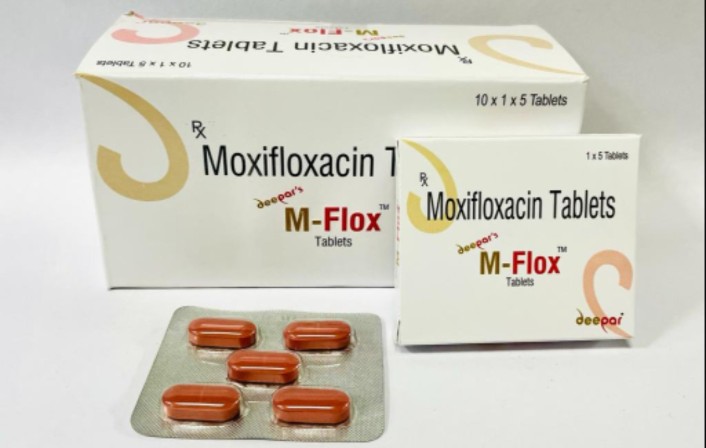
Moxifloxacin Overview
Moxifloxacin is a broad-spectrum fluoroquinolone antibiotic used to treat various bacterial infections. It works by inhibiting bacterial DNA gyrase and topoisomerase IV, enzymes essential for bacterial DNA replication, transcription, and repair, leading to bacterial death. Moxifloxacin is particularly effective against both gram-positive and gram-negative bacteria.
Available Forms and Strengths
- Tablets: 400 mg
- Injectable solution: 400 mg/250 mL (intravenous infusion)
- Ophthalmic solution (eye drops): 0.5% concentration
- Oral suspension: Not commonly available.
Uses of Moxifloxacin
- Respiratory tract infections: Including community-acquired pneumonia (CAP), acute bacterial sinusitis, and acute exacerbations of chronic bronchitis.
- Skin and skin structure infections: Treatment of complicated and uncomplicated skin infections.
- Intra-abdominal infections: Such as complicated intra-abdominal infections.
- Bacterial conjunctivitis: The ophthalmic form is used to treat eye infections.
- Tuberculosis (off-label): Used as part of combination therapy for multidrug-resistant tuberculosis (MDR-TB).
- Plague: Moxifloxacin is FDA-approved for the treatment of plague caused by Yersinia pestis.
Side Effects of Moxifloxacin
- Gastrointestinal issues: Nausea, vomiting, diarrhea, and abdominal pain.
- Central nervous system effects: Headaches, dizziness, confusion, anxiety, and rarely seizures.
- Tendon damage: Risk of tendonitis and tendon rupture, especially in older adults and those taking corticosteroids.
- QT prolongation: Moxifloxacin can cause changes in heart rhythm (prolonged QT interval), which may lead to serious arrhythmias.
- Peripheral neuropathy: Can cause tingling, numbness, or weakness in extremities.
- Allergic reactions: Rash, itching, swelling, or, in rare cases, anaphylaxis.
Dosage Guidelines
- Adults: The standard dose for most infections is 400 mg once daily, administered either orally or intravenously.
- Respiratory infections: 400 mg once daily for 5–14 days, depending on the infection.
- Skin infections: 400 mg once daily for 7–21 days.
- Intra-abdominal infections: 400 mg once daily for 5–14 days.
- Bacterial conjunctivitis (ophthalmic): Instill one drop into the affected eye(s) 2-3 times daily for 7 days.
Important: Moxifloxacin can be taken with or without food but should be taken at the same time each day to maintain consistent blood levels.
Contraindications
- Known allergy to moxifloxacin or fluoroquinolones: Avoid use in patients who have previously experienced hypersensitivity reactions to these drugs.
- Tendon disorders: Patients with a history of tendon disorders related to fluoroquinolone use should avoid moxifloxacin.
- Children and adolescents: Not recommended due to concerns about cartilage damage.
- Pregnancy and breastfeeding: The safety of moxifloxacin during pregnancy and breastfeeding has not been established.
Warnings and Precautions
- Tendonitis and tendon rupture: Fluoroquinolones, including moxifloxacin, are associated with an increased risk of tendonitis and tendon rupture, especially in elderly patients and those taking corticosteroids.
- QT prolongation: Avoid moxifloxacin in patients with a history of QT prolongation, uncorrected hypokalemia, or those taking other drugs that prolong the QT interval.
- Peripheral neuropathy: Discontinue use if the patient experiences symptoms of peripheral neuropathy to avoid permanent nerve damage.
- CNS effects: Moxifloxacin can cause CNS side effects such as seizures, confusion, and tremors. Use with caution in patients with known CNS disorders.
- Myasthenia gravis: Moxifloxacin can exacerbate muscle weakness in patients with myasthenia gravis, and its use is not recommended in these patients.
- Photosensitivity: Rare, but patients should be advised to avoid excessive sunlight or UV light exposure while taking moxifloxacin.
Special Instructions
- Hydration: Drink plenty of fluids while taking moxifloxacin to avoid crystalluria (crystals in urine).
- Avoid antacids: Do not take antacids containing magnesium, aluminum, or iron supplements within 2 hours before or after taking moxifloxacin, as they can interfere with absorption.
- Monitor heart rhythm: Patients at risk for QT prolongation should be closely monitored using an ECG.
- Report tendon pain: Any new or unusual joint or tendon pain should be reported to a healthcare provider immediately.
Drug Interactions
- Antiarrhythmics: Drugs like amiodarone, quinidine, and sotalol can increase the risk of QT prolongation.
- Corticosteroids: Concurrent use increases the risk of tendon rupture.
- Anticoagulants: Moxifloxacin can increase the effect of warfarin, raising the risk of bleeding.
- NSAIDs: Increased risk of CNS stimulation and seizures when taken with nonsteroidal anti-inflammatory drugs.
Moxifloxacin is a potent and widely used antibiotic, but like all fluoroquinolones, it should be used with caution due to its potential side effects and drug interactions.






